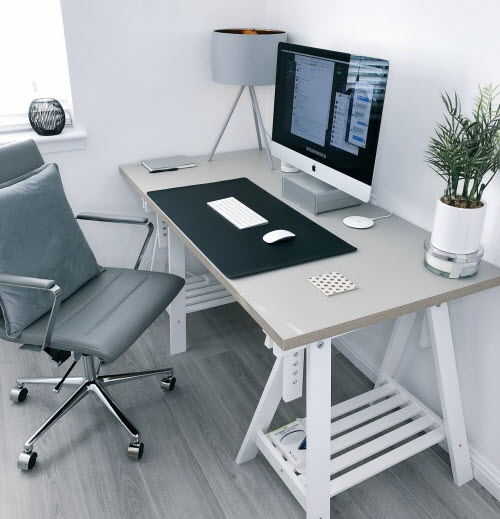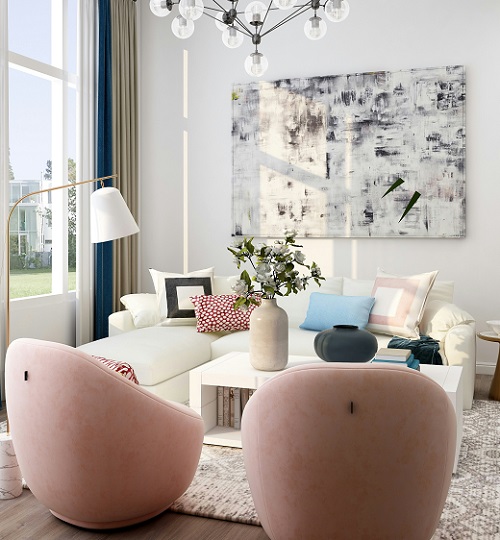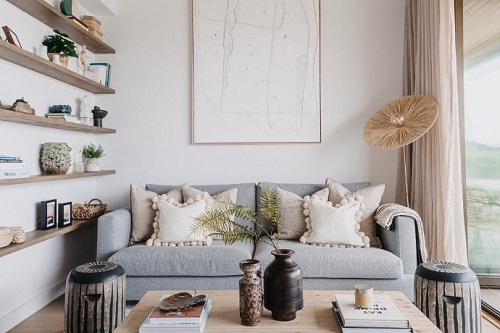Creating an Efficient Desk for a Home Office
By Pamela Wong
Pamela is a Trained Professional Organizer based in Oakville, Ontario and is the owner of Zen N Organized. She helps homeowners and small business owners transform their homes and home offices into organized spaces. She has a practical, non-judgemental approach to organizing. Her objective is to create functional and harmonious spaces for her clients.

An efficient desk can make a significant difference in productivity and work satisfaction. Whether you’re balancing remote work with family responsibilities or managing a home-based business, your desk is the command center of your professional life.
This blogpost lays out steps to set up an efficient desk that will enhance productivity, promotes focus, and supports your work-from-home needs.
Step 1: Choose the Right Furniture
- Select a Suitable Desk:
- Size and Shape: Choose a desk that fits your space and provides ample surface area for your needs. L-shaped desks are great for multitasking, while compact desks work well in smaller spaces.
- Invest in an Ergonomic Chair:
- Comfort, Support and Mobility: Choosing a chair with as many adjustment points as possible, good cushioning and back support and wheels or castors can help with your physical and mental health as well as productivity.
Step 2: Organize Your Desk Layout
- Position Your Monitor:
- Eye Level and Positioning: Place your monitor at eye level to avoid neck strain. Use a monitor stand if necessary and position the monitor about 20 inches away from your eyes for optimal viewing comfort.
- Arrange Essential Tools:
- Keyboard, Mouse and Office Tool: Keep all accessories and needed tools in a close and accessible area. The most frequently used items should take up the most accessible real estate (ie. Desk, shelves within arm’s reach, top drawer).
Step 3: Optimize Your Desk Storage
- Use Desk Drawers:
- Categorize Items: Assign specific drawers for different categories of items, such as office supplies, documents, and personal items. Using organizers or dividers will keep the contents of each drawer neat and easy to find.
- Incorporate Vertical Storage:
- Shelves and Wall Organizers: Install shelves or wall-mounted organizers above or beside your desk to free up desk space while keeping your books and binders close.
- Pegboards: Use pegboards for hanging tools, accessories, and inspiration boards, adding both functionality and a personal touch to your workspace.
Step 4: Manage Cables and Technology
- Cable Management:
- Cable Clips and Trays: Keeping cables near with clips and raceway can keep a neat look while having access to all your cables.
- Label Cables: Label each cable to easily identify and manage connections for your computer, printer, and other devices.
- Technology Integration:
- Docking Stations: Consider using a docking station to connect multiple devices wirelessly, reducing cable clutter and easier device switching.
- Wireless Devices: Opt for wireless accessories like keyboards and printers to minimize the number of cables on your desk.
Step 5: Enhance Lighting
- Natural Light:
- Desk Placement: Position your desk near a window to take advantage of natural light boosting mood and productivity.
- Window Treatments: Use adjustable blinds or curtains to control the amount of light and reduce screen glare.
- Task Lighting:
- Desk Lamp: Invest in a good quality desk lamp with adjustable brightness and direction. This ensures adequate lighting for tasks like reading, writing, and computer work.
- Ambient Lighting: Complement your desk lamp with ambient lighting in the room to reduce eye strain and create a comfortable work
Step 6: Personalize Your Space
- Incorporate Personal Touches:
- Decorative Items: Add photos, artwork, or plants to personalize your desk and make it a more enjoyable place to work.
- Inspiration Board: Create an inspiration board with quotes, goals, and images that motivate you.
- Color Scheme:
- Calming Colors: Choose a color scheme that promotes focus and calmness. Soft blues, greens, and neutral tones are often recommended for home offices.
Step 7: Maintain a Clutter-Free Desk
- Daily Clean-Up:
- End-of-Day Routine: Develop a routine to tidy up your desk at the end of each workday. This helps maintain organization and prepares you for a productive start the next day.
- Minimalist Approach: Keep only essential items on your desk and store the rest. A clutter-free desk reduces distractions and improves focus.
- Regular Purging:
- Monthly Review: Set aside time each month to review and purge unnecessary items from your desk and storage areas. This keeps your workspace efficient and clutter-free.
Step 8: Ergonomics and Health
- Monitor Ergonomics:
- Screen Position: Ensure your monitor is directly in front of you, with the top of the screen at or slightly below eye level.
- Screen Distance: Maintain a distance of about 20 inches between your eyes and the screen to reduce eye strain.
- Physical Comfort:
- Footrest: Use a footrest if your feet don’t comfortably reach the floor, helping to maintain proper posture.
- Desk Mat: Consider using an anti-fatigue mat if you have a standing desk setup.
Step 9: Digital Organization
- File Management:
- Organized Folders: Create a clear and organized digital filing system for your work documents.
- Cloud Storage: Use cloud storage services like Google Drive, Dropbox, or OneDrive to back up important files and access them from anywhere.
- Email Management:
- Inbox Zero: Aim to keep your email inbox organized by sorting emails into folders, deleting unnecessary messages, and responding promptly to important ones.
Setting up and creating an efficient desk is essential for many professionals working from home. Following these steps, you can transform your desk into a productive, organized, and inspiring workspace. Start today and enjoy the benefits of efficiency and comfort!



